FAKE NEWS
>
Shutrbugjo
>
RESEARCH
>
Evaluating Sources & Website Credibility
EdWebet #75 - Digital Literacy. Hoaxy® by OSoMe. OSoMe: BotSlayer. BotSlayer is an application that helps track and detect potential manipulation of information spreading on Twitter.
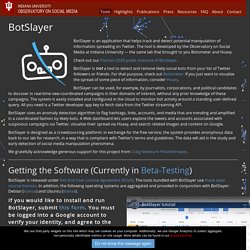
The tool is developed by the Observatory on Social Media at Indiana University --- the same lab that brought to you Botometer and Hoaxy. Check out our Election 2020 public instance of BotSlayer. BotSlayer is not a tool to detect and remove likely social bots from your list of Twitter followers or friends. For that purpose, check out Botometer. If you just want to visualize the spread of some piece of information, consider Hoaxy. BotSlayer can be used, for example, by journalists, corporations, and political candidates to discover in real-time new coordinated campaigns in their domains of interest, without any prior knowledge of these campaigns. BotSlayer uses an anomaly detection algorithm to flag hashtags, links, accounts, and media that are trending and amplified in a coordinated fashion by likely bots. Getting the Software (Currently in Beta-Testing) Usage Warnings Step 1.
Fakey. Information Overload Helps Fake News Spread, and Social Media Knows It.
Consider Andy, who is worried about contracting COVID-19.
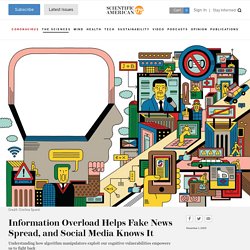
Unable to read all the articles he sees on it, he relies on trusted friends for tips. When one opines on Facebook that pandemic fears are overblown, Andy dismisses the idea at first. But then the hotel where he works closes its doors, and with his job at risk, Andy starts wondering how serious the threat from the new virus really is. No one he knows has died, after all. A colleague posts an article about the COVID “scare” having been created by Big Pharma in collusion with corrupt politicians, which jibes with Andy's distrust of government. This example illustrates a minefield of cognitive biases. Modern technologies are amplifying these biases in harmful ways, however. Compounding the problem is the proliferation of online information. The need to understand these cognitive vulnerabilities and how algorithms use or manipulate them has become urgent.
InVID Verification Plugin - InVID project. Get the tool! It’s free!
Chrome Firefox Details about the tool This toolkit is provided by the InVID european project to help journalists to verify content on social networks (please note that external InVID services used via this interface, such as those presented under the Analysis and Keyframes tabs, are not open-sourced).
It has been designed as a verification “Swiss army knife” helping journalists to save time and be more efficient in their fact-checking and debunking tasks on social networks especially when verifying videos and images. Access menu This is a new feature (supported in v0.59) to access the InVID plugin and to help journalists to retrieve video and image URLs within the code of a web page.
Interactive Media Bias Chart - 2 - Ad Fontes Media. List of Resources - Fake News and the Post-Truth Era - LibGuides at Columbia College (SC)
Barclay, D.
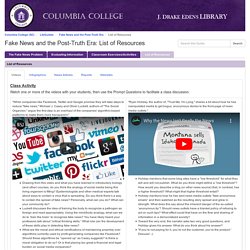
A. (2017, January 4). The challenge facing libraries in an era of fake news. The Conversation.
The Fake News Problem - Fake News and Media Literacy - Research Guides at Santa Fe Community College. While not a new phenomenon, the proliferation of fake news has gained dangerous traction in recent years, particularly in the arena of social media platforms such as Twitter and Facebook.
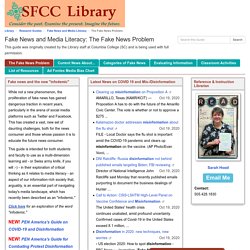
This has created a vast, new set of daunting challenges, both for the news consumer and those whose passion it is to educate the future news consumer. This guide is intended for both students and faculty to use as a multi-dimension learning aid - or Swiss army knife, if you will :-) - in their exploration of critical thinking as it relates to media literacy - an aspect of our information-rich society that, arguably, is an essential part of navigating today's media landscape, which has recently been described as an "infodemic.
" Click here for an exploration of the word "infodemic.
" NEW! PEN America's Guide on COVID-19 and Disinformation NEW!
Fake News Curriculum Resources - Media Literacy Clearinghouse. Media Literacy Clearinghouse The Media Literacy Clearinghouse is a nationally recognized media literacy resource website.
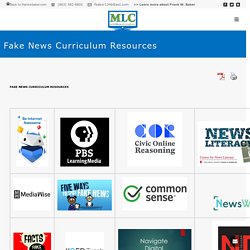
Thousands of schools and organizations link to the Media Literacy Clearinghouse and many of his resources have been recommended by: Academy of Motion Picture Arts & Sciences; Access Learning; ASCD; Assn of Media Literacy; Australian Teachers of Media; Blueprint for Democracy; Cable In The Classroom; Education Week; Edutopia; INFOHIO; NCSS; NCTE; PBS; School Library Journal, and School Library Monthly. Media Literacy Clearinghouse makes available some copyrighted material. We understand our use of any such copyrighted material to constitute a "fair use" as provided for in section 107 of the US Copyright Law. In accordance with Title 17 U.S.C.
Media Literacy Clearinghouse. News Literacy Must Include Social Emotional Learning School Library Journal. Get Smart About Memes School Library Journal.
A Deep Dive into Deep Fakes Media Literacy in a World Where Seeing Is no Longer Believing School Library Journal. The Importance of Critical Thinking in the Age of Fake News. How To Recognize A Fake News Story. If you’ve been looking at Facebook lately, you may have seen that Pope Francis endorsed Donald Trump, a town in Texas was quarantined due to a deadly disease and Germany just approved child marriage.
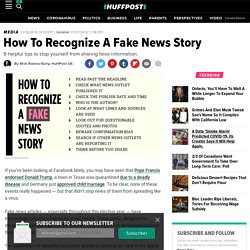
To be clear, none of these events really happened ― but that didn’t stop news of them from spreading like a virus. Fake news articles ― especially throughout this election year ― have increasingly become a fixture on social media. These posts, designed to deceive, run rampant across the internet. Only later, if ever, do readers discover that the stories they shared may have been false. The publication of blatantly inaccurate stories is certainly not new to the digital age, or even the analog era ― just check your local supermarket aisle for tabloids ― but what is new is how easy it is for a reader to scan a headline on Facebook, hit share and watch his 500 followers do the same.
The Moses Illusion Shows How Bad You Are at Fact-Checking. Fake News Quiz - Fake News - Research Guides at Thompson Rivers University Library. Fake News is easy to fall for, for a number of reasons: a growing decline in trust of the media and government people can now create content unburdened by the layers of editing and fact-checking that news organisations adhere to content is aggregated into a single “news” feed – mixing updates from friends and family with identical-looking links to stories across the web lower attention spans fake news stories appeal to our emotions proliferation of internet bots Bias.
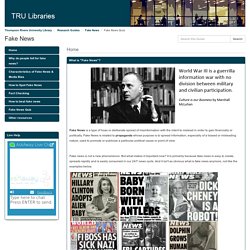
Real or fake? Take our fake news quiz to find out. Powered by There's one question readers ask us more than any other about fake news: How can we even begin to tell if a story is fabricated, or if a news source is untrustworthy?
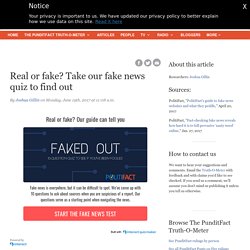
Hundreds (if not thousands) of online outlets try to trick people into clicking on, believing in and sharing their made-up wares. It can be exceptionally difficult to determine whether a report can be taken at face value. After spending months sorting through news stories we've proven are fake, we've identified some common elements among bogus reports. We're here to help, with this handy quiz that can help guide you as you read.
Web Literacy for Student Fact-Checkers – Simple Book Production. Where Do I Check? - Fact Checking, Verification & Fake News - LibGuides at John Jay College of Criminal Justice, CUNY. Here are some specific suggested resources: FactCheck.org - A "nonpartisan, nonprofit" research center out of the University of Pennsylvania.
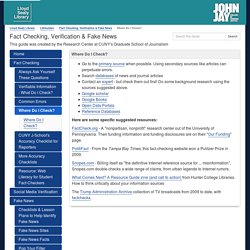
Their funding information and funding disclosures are on their "Our Funding" page. PolitiFact - From the Tampa Bay Times, this fact-checking website won a Pulitzer Prize in 2009. Snopes.com - Billing itself as "the definitive Internet reference source for ... misinformation", Snopes.com double-checks a wide range of claims, from urban legends to Internet rumors. What Comes Next? The Trump Administration Archive collection of TV broadcasts from 2009 to date, with factchecks.
Teaching fact vs. fiction when seeing is no longer believing. Many Americans Say Made-Up News Is a Critical Problem That Needs To Be Fixed. Politicians viewed as major creators of it, but journalists seen as the ones who should fix it Many Americans say the creation and spread of made-up news and information is causing significant harm to the nation and needs to be stopped, according to a new Pew Research Center survey of 6,127 U.S. adults conducted between Feb. 19 and March 4, 2019, on the Center’s American Trends Panel.

Indeed, more Americans view made-up news as a very big problem for the country than identify terrorism, illegal immigration, racism and sexism that way. Additionally, nearly seven-in-ten U.S. adults (68%) say made-up news and information greatly impacts Americans’ confidence in government institutions, and roughly half (54%) say it is having a major impact on our confidence in each other. U.S. adults blame political leaders and activists far more than journalists for the creation of made-up news intended to mislead the public.
(27) Why Do Our Brains Love Fake News?
People Are Posting Examples Of How Media Can Manipulate The Truth (12 Pics) – WebMDI. The traditional TV news media has been having a rough time in the last few years. According to arecent survey, more Americans have a negative (43%) than a positive (33%) view of the mass media, and are finding it harder to be well informed because it is getting harder to determine which news is accurate.
So what is media’s biggest problem? It’s bigotry. While ideally all types of media should be objective and hold power to account, in reality, we know that most news outlets are partisan and have their agenda to advance.
Assessing Trustworthy Sources Handout EBSCO. Ferret Out Fake News Flyer us EBSCO. Fake News: A Library Resource Round-Up. How Fake News Goes Viral: A Case Study. Eric Tucker, a 35-year-old co-founder of a marketing company in Austin, Tex., had just about 40 Twitter followers. But his recent tweet about paid protesters being bused to demonstrations against President-elect Donald J. Trump fueled a nationwide conspiracy theory — one that Mr.
Trump joined in promoting. Mr. Tucker's post was shared at least 16,000 times on Twitter and more than 350,000 times on Facebook. But that didn't matter. While some fake news is produced purposefully by teenagers in the Balkans or entrepreneurs in the United States seeking to make money from advertising, false information can also arise from misinformed social media posts by regular people that are seized on and spread through a hyperpartisan blogosphere. Here, The New York Times deconstructs how Mr. Mr. Mr.
From Headline to Photograph, a Fake News Masterpiece. The city getting rich from fake news. Welcome to Macedonia, Fake News Factory to the World: EBSCOhost. Finding Real News - Fake News and Alternative Facts: Finding Accurate News - LibGuides at Austin Community College. Home - Fake News and Alternative Facts: Finding Accurate News - LibGuides at Austin Community College.
Home - Evaluating Information - LibGuides at American Library Association. Ischool fake news handout. Resource links. Media Literacy at Your Library. 5 Ways to Spot Fake News Video. Fact vs. Fiction in the Media. Fact vs. Fiction in the Media. Fact-Checking. TEDxUniversityofNevada. How Fake News Grows in a Post-Fact World. Why Do Our Brains Love Fake News?
Top 4 Tips To Spot Bad Science Reporting. Estes Valley Library presentation. IFLA Statement on Fake News. The phenomenon of ‘fake news’ has risen to prominence in many countries, regularly appearing in political debate.
IFLA is concerned by the risk that this can pose to access to information, where people do not have the skills to spot it, but also by the way it is used by governments to justify potentially repressive policies. The Chair of the IFLA Advisory Committee on Freedom of Access to Information and Freedom of Expression, Martyn Wade, said 'Freedom of access to information is a right of all, and the increase in activities intended to deliberately mislead citizens leads inevitably to damaging everyone's human rights'.
This statement sets out IFLA's position on fake news, and makes recommendations to governments and libraries.
Fake News 101. I Found It On the Internet, It Must Be True: Fact vs. Opinion for Middle School Students. Actual text message exchange between one of the authors of this blog and her child:
Choice page. NPR Choice page. The Hidden Audience of the Factitious News Game – Bob Hone. Clever Workaround For Sara Hood, reference librarian at the Santa Fe Community College library, the original Factitious game wasn’t configured to support the information literacy workshops she presents at the college. That game version would pull 15 articles at random from a set of 45 possible articles to allow players to play the game multiple times.
Fake News: A Library Resource Round-Up. The Truth Is Out There: Fact-Checking Resources for Students. Do you ever feel like you have slipped into an episode of "The Twilight Zone" or "The X-Files" when you see some of the “facts” your students share?
Top 10 sites to help students check their facts. News Literacy. Checkology. Fact-checking U.S. politics. Fake It To Make It. How to Use Google Reverse Image Search to Fact Check Images. Evaluating Sources in a ‘Post-Truth’ World: Ideas for Teaching and Learning About Fake News. Back in 2015, when we published our lesson plan Fake News vs. Real News: Determining the Reliability of Sources, we had no way of knowing that, a year later, the Oxford Dictionaries would declare “post-truth” the 2016 word of the year; that fake news would play a role in the 2016 presidential election; that it would cause real violence; and that the president-elect of the United States would use the term to condemn mainstream media outlets he opposes.
Back then, to convince teachers that the skill was important, we quoted Peter Adams of the News Literacy Project on the “digital naïveté” of the “digital natives” we teach. Now, however, we doubt that we need to convince anyone.
Learning To Spot Fake News: Start With A Gut Check : NPR Ed. 5 Takeaways from News Literacy EdCamp. My 4 Favorite Digital Literacy Articles of 2017. Remembering the Brooklyn Bridge Elephant Stampede That Never Happened. Brooklyn Bridge Elephant Stampede Home. Staten Island Ferry Disaster Memorial Museum -
Artist fools tourists with monument to giant-octopus attack on Staten Island Ferry. It’s the city’s secret tragedy: the giant-octopus attack on the Cornelius G. Kolff, a Staten Island Ferry boat dragged to a watery grave with 400 souls aboard on Nov. 22, 1963.
Few recall the harbor horror because news coverage was eclipsed by the shocking assassination of John F. Kennedy in Dallas that very day. Also because it never actually happened.
High School Activity Headlines – Google Drive. First Draft News -
7 vital browser plugins for newsgathering and verification. UPDATE – This article was originally published on Jan 6 2016, but has been updated with the first two tools. Know of any others we may have missed? Let us know on Twitter. When breaking news can travel the world in seconds, it is important for journalists to have the tools at their disposal to get to work fast. When searching the web, what quicker way is there to have those tools available than directly in the browser window?
Latest Email Hoaxes - Current Internet Scams - Hoax-Slayer. Urban Legends. Rumors, hoaxes, and urband legends - TruthorFiction.com. 13 online tools that help to verify the authenticity of a photo. #alternativefacts. Propaganda (noun): Information that is often exaggerated or false and spread for the purpose of benefiting or promoting a specific individual or cause.
Digital Literacy Vocabulary. Teaching Tolerance. Stony Brook Center for News Literacy. The full News Literacy course, developed at Stony Brook University, organizes the material into 8 concepts that are spread amongst our 14 week course that take students from the first information revolution of Johannes Gutenberg's printing press to the Digital Age of Mark Zuckerberg's Facebook.
Each lesson stands alone or can easily be integrated into your program. Below, find a summary of each of those lessons, and a link to the most updated version of the teaching materials for each from our professors at Stony Brook University. Each of the following Course Packs include PowerPoint presentations, associated media, lecture notes, and recitation materials. You will notice as the semester progresses, the name of some of our lessons change, along with the sequence of the lessons.
Stony Brook Center for News Literacy.
The Definitive List of 176 Fake News Sites on Facebook. How to choose your news - Damon Brown. Comment choisir vos informations - Damon Brown. Teacher-Librarians. Hoaxy™
Fact-checking U.S. politics. FactCheck.org - A Project of The Annenberg Public Policy Center. Media Bias/Fact Check - Search and Learn the Bias of News Media. Fake News, Misinformation, and Propaganda. If you've fallen prey to fake news, you're not alone. “Factitious” Is An Online Game To Teach About Fake News. The News Literacy Project. Truth, truthiness, triangulation: A news literacy toolkit for a “post-truth” world.
Fake News, Misinformation, and Propaganda. The News Literacy Project. Jayson Blair Plagiarism Scandal. False, Misleading, Clickbait-y, and Satirical “News” Sources. Fake Facebook News Sites to Avoid.










